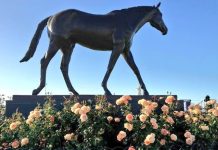By Andrew Atkinson
York’s Ebor 2020 Festival’s behind closed doors meeting will leave absent spectators licking their lips – as they miss out on a dining experience at the historic racecourse.
“We look forward to welcoming owners to the second day of the @Welcome2Yorks Ebor Festival,” said a spokesperson ahead of Friday’s (August 21) meeting.
Many punters will call for a ‘Stewards enquiry’ – after a glance of the Desert menu and part of a three course lunch – amid the coronavirus situation, that sees members of the public banned from being present this year, due to COVID-19 concerns.
A limited number of owners, trainers, jockeys and staff permitted to attend are in for a treat: “Here’s a sneak peek of the dessert menu they will be enjoying as part of a three course lunch,” said the spokesperson.
Desserts include Raspberry Eton Mess, Rich Dark chocolate Torte, Slingsby Rhubarb Gin Compote (gf), Wensleydale & Cranberry.

York Corporation records show that the City first fully supported racing in 1530. In 1607, racing is known to have taken place on the frozen river Ouse, between Micklegate Tower and Skeldergate Postern.
The first detailed records of a race meeting date from 1709, when much work was done to improve the course at Clifton Ings which was prone to flooding. Despite this work, the flooding continued and in 1730 racing transferred to Knavesmire, where today’s course remains.
As its name implies, Knavesmire was a mire with a stream running through it and a considerable amount of levelling and draining was required to create the horseshoe shaped course, which opened for its first meeting in 1731.
No permanent buildings were erected on Knavesmire until the noted York architect, John Carr, designed and built the first Grandstand in 1754. This was financed by 250 people who each paid 5 guineas.
Every patron and their successors were entitled to use the stand for the period of the site’s lease, and were issued with a brass token bearing their name and an image of the stand.

The York Racecourse Committee, (now part of York Racecourse Knavesmire LLP) still manages racing at York today, and was formed in 1842, to turn around a decline in the quality of racing.
By 1846, the Committee had introduced the Gimcrack Stakes, which has since become one of York’s most enduring races.
York’s richest race, the prestigious Group One Juddmonte International is the highlight of the opening day of the Welcome to Yorkshire Ebor Festival, the contest was independently ranked as the best race in Great Britain by the International Federation of Horseracing Authorities last season.
York Races’ progression has been reflected in the development of the grandstands over the years.
New stands were erected in 1890 to incorporate much of the original building and a major improvement scheme, launched in 1962, led to the opening of the five-tier grandstand in 1965.
Photographs: courtesy York Racecourse.









